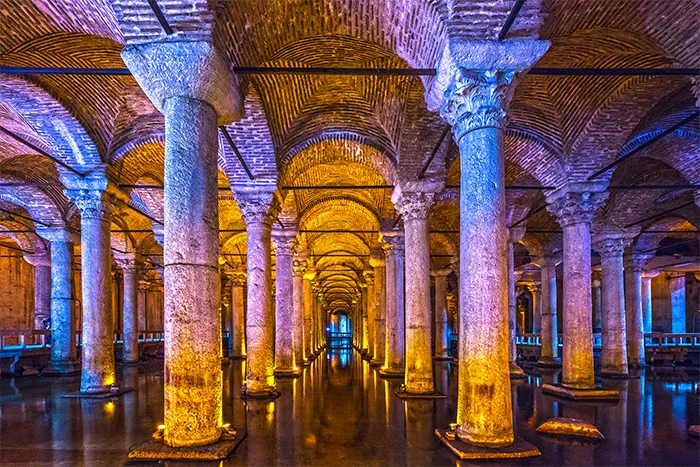Istanbul: A City of History and Heritage
Introduction
Istanbul, Türkiye’s largest city, is uniquely positioned in the northwest of the country, spanning both Europe and Asia. It is divided by the Bosphorus Strait, connecting the Black Sea to the Mediterranean. Established in the 7th century BC, Istanbul has been a hub for multiple civilizations and empires, leaving behind a wealth of historical and archaeological treasures. The city’s Historical Peninsula, designated as a UNESCO World Heritage Site in 1985, is home to some of its most iconic landmarks.

Hagia Sophia Grand Mosque (Ayasofya-i Kebîr Cami-i Şerîfi)
One of Istanbul’s most renowned landmarks, the Hagia Sophia was originally built in the 6th century AD as an Eastern Roman basilica. In 1453, Sultan Mehmed II converted it into a mosque, later transforming it into a museum in 1935, and finally redesignating it as a mosque in 2020. Its impressive 31-meter-wide dome was the largest in the Eastern Roman Empire and remains a dominant feature of Istanbul’s skyline today.
ALSO READ: Digging Caesar’s Forum Three thousand years of daily life in Rome
Blue Mosque (Sultanahmet Mosque)
Adjacent to Hagia Sophia, the Blue Mosque was constructed between 1609 and 1616 during the Ottoman era. It incorporates elements of Eastern Roman architecture alongside traditional Islamic design. The mosque’s six minarets and 20,000 İznik tiles, which give it a striking blue hue, contribute to its grandeur. Nearby, Sultanahmet Square, once the Hippodrome of Constantinople, hosted public events such as chariot racing.

Topkapı Palace
Located on Seraglio Point overlooking the Golden Horn, Topkapı Palace was built in the 15th century and served as the residence of Ottoman sultans and the empire’s administrative center for centuries. Today, it functions as a museum, housing Ottoman artifacts, religious relics, and manuscripts. Visitors can explore the Imperial Harem, the treasury, and other sections of the vast palace complex.
Basilica Cistern
Hidden beneath the city, the Basilica Cistern is the largest of Istanbul’s underground water reservoirs. Constructed by Emperor Justinian I in the 6th century AD, it spans 9,800 square meters and could store 80,000 cubic meters of water. The cistern is supported by 336 marble columns, some of which were repurposed from older buildings. Notably, two column bases in the northwest corner feature Medusa heads, positioned upside down and sideways, sparking theories about their purpose.

Galata Tower
Standing across the Golden Horn, the Galata Tower was built in 1348 by the Genoese settlers. At nearly 63 meters tall, it was the city’s tallest structure for centuries. Today, it offers panoramic views of Istanbul and houses a museum displaying artifacts from the city’s history.
Maiden’s Tower (Leander’s Tower)
Situated on a small island at the southern entrance of the Bosphorus Strait, the Maiden’s Tower dates back to the Eastern Roman period. It has served various functions, including a lighthouse and a quarantine station, and now operates as a café and restaurant with spectacular views of Istanbul.
Other Historical Landmarks
Beyond the Historical Peninsula, Istanbul is home to numerous other remarkable sites:
- Süleymaniye Mosque – A grand Ottoman mosque designed by architect Mimar Sinan.
- Dolmabahçe Palace, Çırağan Palace, and Beylerbeyi Palace – Extravagant residences showcasing Ottoman opulence.
- Grand Bazaar – One of the oldest covered markets in the world, offering a vibrant shopping experience.
- Rumeli Hisarı and Anadolu Hisarı – Medieval fortresses on opposite shores of the Bosphorus.
- City Walls of Constantinople – Large sections of these ancient defenses remain intact, reflecting the city’s rich past.

Conclusion
Istanbul’s historical richness is evident in its diverse monuments, churches, mosques, aqueducts, palaces, and mansions. Walking through the city feels like stepping back in time, with history woven into every corner. Whether exploring grand mosques, ancient cisterns, or bustling bazaars, Istanbul remains a living testament to its storied past.


